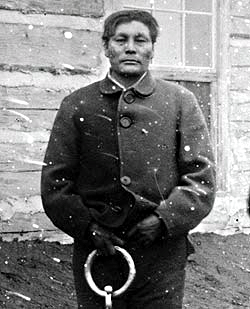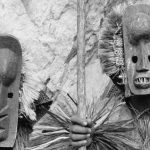On a cold December day in 1879, a man was hanged in Fort Saskatchewan, putting an end to one of the most horrifying killing sprees in Alberta history.
Swift Runner was executed for murdering and then eating eight members of his own family over the previous winter.
He believed he was possessed by Windigo, a terrifying mythological creature with a ravenous appetite for human flesh.

It wasn’t an isolated case. During the late 1800s and into the 20th Century, fear of Windigo haunted northern Alberta communities, resulting in several grisly deaths.
Some called him a serial killer. Others said he was a desperate madman.
But right up until the trap door swung open and the rope snapped taut around his neck, one of Alberta’s most prolific murderers insisted it was an evil spirit that compelled him to butcher and eat his entire family.
Over the course of a single winter, he devoured his wife, six children, mother and brother.
Most Horrifying
The man, a Cree trapper named Swift Runner, was hanged in 1879 in Fort Saskatchewan, the first legal execution in Alberta. The macabre case is considered by many to be the most horrifying crime in the province’s history.
But what most people don’t realize is that it was part of a much larger phenomenon that Edmonton ethno-historian Nathan Carlson calls Windigo condition, which haunted communities right across northern Alberta in the late 19th and early 20th Centuries and cost dozens of lives.
The Windigo (an Anglicized form of the word Witiko) is a mythological creature among native cultures from the Rockies to northern Quebec. It has an insatiable appetite for human flesh and wreaks destruction wherever it goes.
Carlson describes it as “the consummate predator of humanity.” It’s sometimes described as “an owl-eyed monster with large claws, matted hair, a naked emaciated body and a heart made of solid ice.”
“It’s extremely destructive,” he says. “The more it eats, the hungrier it gets, so it just keeps killing.”
Windigos can possess people, transforming them into wild-eyed, violent, flesh-eating maniacs with superhuman strength. Many native people in northern Alberta lived in terror of being possessed.
“It’s important to understand that cannibalism was repellent to the people,” Carlson explains. “The Windigo personified evil.”
The Swift Runner case caused an international sensation, making headlines in newspapers across Canada and the U.S.
According to accounts, he wandered alone into the Catholic Mission in St. Albert in the spring of 1879, claiming to be the only member of his family who didn’t starve to death over a particularly cold, bitter winter.
The priests became suspicious when they realized that Swift Runner, who weighed around 200 pounds, didn’t seem malnourished at all and was plagued with screaming fits and nightmares as he slept. He told them he was being tormented by an evil spirit, called Windigo, but said little else about it.
They reported their misgivings to police, who took Swift Runner to his family campground in the woods northeast of Edmonton, where they made a horrific discovery – the site was littered with bones, bits of flesh and hair. Some accounts claim that the larger bones had even been snapped and the marrow sucked out.
He eventually confessed that he shot some of his family, bludgeoned others with an axe and even strangled one girl with a cord. In some accounts, Swift Runner said he fed one boy human flesh before he too was killed.
The Least Of Men
Before he was hanged, Swift Runner expressed extreme remorse. He told Father Hippolyte Leduc, “I am the least of men and do not merit even being called a man.”
Interestingly, Swift Runner is the only documented case Carlson can find of someone killing others because he thought he was possessed by a Windigo.
All other deaths he can document were cases of “Windigo executions,” where others have killed the person believed to be possessed. They were acts of self-preservation, attempts to protect their community.
In most of the cases, the victims themselves begged to be killed before they harmed their families.
In many cases, witnesses reported physical changes – bodies swelling and growing, lips and mouths enlarging. Some of the victims spoke of icy cold in their chests and an inability to warm up.
Carlson first heard about the Windigo from his grandmother, who told him about an incident at Trout Lake, where members of the community killed a man possessed by a demon that had been cursed and turned into a Windigo.
The story haunted him throughout his childhood, and after his grandmother died in 2002, he discovered an eerily similar story in an archived newspaper.
“I was somewhat confounded by the discovery of the newspaper account that seemed to confirm a story that had been in my family for almost 100 years,” he says.
Further research revealed that the man who was killed was also a distant relative of Carlson’s.
Image: Swift Runner before his execution at Fort Saskatchewan in 1879
Author: Andrew Hanon







